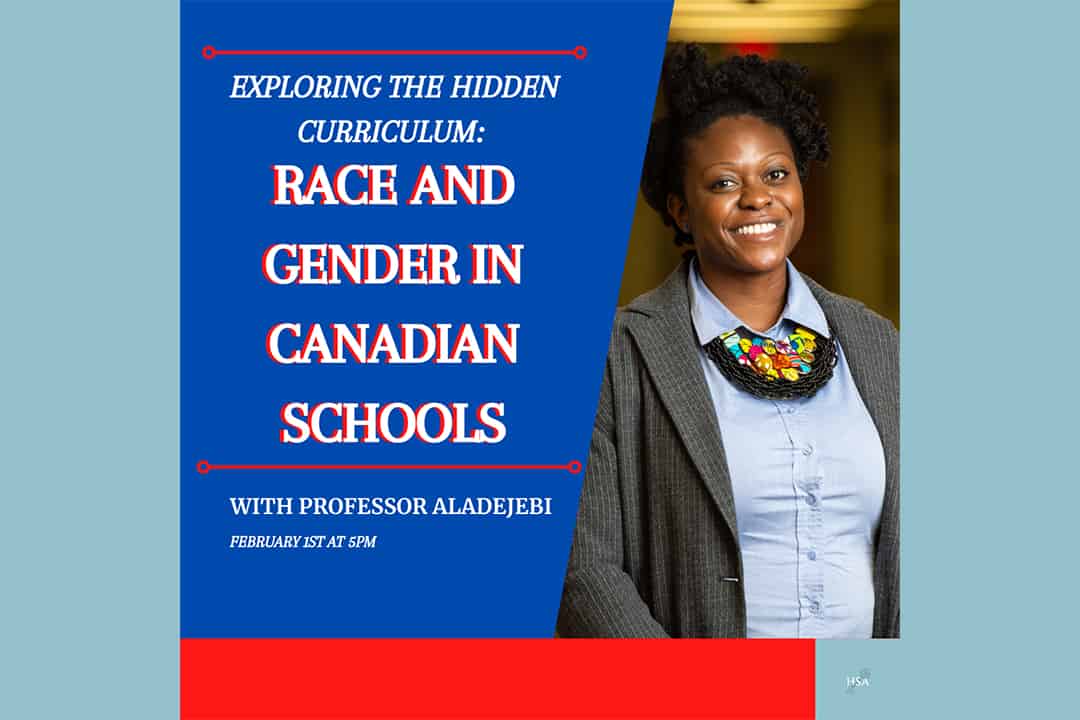What can the oral histories of Black women educators tell us about exclusion in Canadian institutions? On February 1, Funké Aladejebi, an assistant professor in the Department of History answered that question in a seminar presented by the U of T History Students’ Association called “Exploring the Hidden Curriculum: Race and Gender in Canadian Schools.”
The hidden curriculum and the paradox of Canadian multiculturalism
According to Aladejebi, who specializes in Black Canadian history, the “hidden curriculum” isn’t a deliberate educational agenda. Rather, as Frances Henry, who originally coined the term, describes it, it’s a concept that accounts for “the different beliefs, assumptions, attitudes, and expectations that teachers bring into schools.”
The hidden curriculum is particularly useful for understanding Canadian school systems, Aladejebi said, because we often think of multiculturalism and racism as dichotomous. “People often believe that we cannot have a school — or even educators, for that matter — who are actively promoting and encouraging diversity while also believing in implicit biases and stereotypes.”
However, Aladejebi’s research revealed that contradictory ideologies are often embedded in Canadian institutions. In the early 2010s, she interviewed several Black women educators, Canadian-born and Caribbean immigrants alike, who taught in Ontario between the 1940s and 1980s. She found that the hidden curriculum was pervasive in school settings: her interviewees faced gendered racism in everyday interactions.
Black women teachers’ qualifications questioned
“Employment equity programs in the 1980s led to substantial gains for women educators, especially surrounding equal pay and access to administrative positions,” Aladejebi said. However, some school administrations and educators used the existence of those programs to suggest that Black women educators were not qualified for their jobs.
In the 1980s, Sheryl, a Canadian-born Black educator, was hired as vice-principal of a Windsor school. Sheryl’s colleagues attributed her professional achievement to equity quotas. She told Aladejebi, “When I got that appointment, some of the teachers said that: ‘well you were a shoo-in when you went to the interview because you are Black and you are a female.’ ”
Aladejebi found that, in response to that “racialized pressure,” Black women sought out additional qualifications and recertifications. They felt like they needed to prove themselves, which subsequently increased their stress levels and workloads.
“Not-quite belonging”
While staff rooms allowed other educators to take breaks, forge relationships, and share knowledge, those spaces became sites of both subtle and overt exclusion for Black women educators.
Harriett, who served as principal of a Catholic Elementary School in mid-1970s Toronto, still remembers a game that her peers played. “They would leave her sitting alone in the staff room,” Aladejebi said. “Whenever she moved tables to go and sit with this group, they would all leave.” In response, Harriet followed those educators around until she gained acceptance and acknowledgement in the staff room.
The hidden curriculum was present in Harriet’s story: “white educators and administrators were unable to see their own biases,” Aladejebi said.
Another educator, Tamara, was completely barred from the staff room at her Toronto school. She refused to eat her lunch in the basement as she was instructed, but told Aladejebi that in order to avoid jeopardizing her job, she “wandered during lunchtime” instead of going to the staff room.
Even when Black women educators were permitted into staff rooms, they encountered conversations containing racial slurs and stereotypes.
“As a result of the both subtle and overt ways that Black women experienced exclusion, they often occupied not-quite spaces of belonging in Canadian schools,” Aladejebi said.
Pedagogies of resistance and dismantling the hidden curriculum
Despite the precarity of their positions, Black women educators actively resisted the hidden curriculum. They re-interpreted curricula to reflect more diverse perspectives and used Black experiences to inform their teaching. In their hands, education became “a tool for social transformation and communal survival.”
Today, creating systemic change remains challenging, said Aladejebi. “Much of our education system has not shifted or adequately restructured its frameworks to create more inclusion for racial minorities.”
Racialized educators should not bear the responsibility of change alone, she argued. Educators and the Canadian public need to “do more to dismantle implicit stereotypes and assumptions within schools.”


